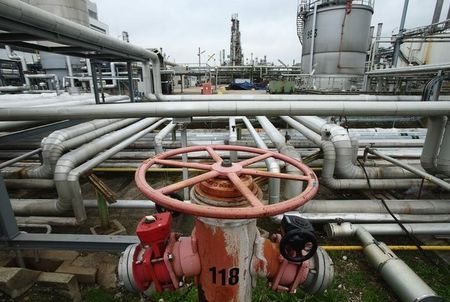
Investing.com– Oil prices rose Wednesday, rebounded from recent lows as signs of tighter U.S. supplies helped soothe some fears over worsening demand in the rest of the globe.
At 09:25 ET (13:25 GMT), Brent oil futures rose 1.3% to $80.78 a barrel, while West Texas Intermediate crude futures climbed 1.1% to $84.64 a barrel.
US inventories shrink more than expected – API
U.S. oil inventories saw a bigger than expected draw in the week to July 12, data from the American Petroleum Institute showed on Tuesday.
Inventories fell 4.4 million barrels, compared to expectations for a draw of 33,000 barrels.
The official numbers, from the Energy Information Administration, are due later Wednesday. And if this data follows the API numbers they would heralds a third consecutive week of draws in U.S. inventories, as travel demand picked up during the summer season.
Signs of strengthening demand in the U.S., the world’s largest economy and largest energy consumer, helped the crude market bounce from recent weakness, with the Brent contract falling to a one-month low on Tuesday.
Oil supply risks remain in focus
Oil prices also steadied as traders remained on watch for any potential supply disruptions due to geopolitical tensions in the Middle East.
Israel continued to carry out strikes on Gaza, keeping tensions with Hamas and Hezbollah elevated. Yemeni groups were also seen carrying out repeated strikes on vessels in the Red Sea, potentially disrupting crude shipments.
This saw traders attach some risk premium to oil prices, although it remained unclear just how much of an impact the disruptions in the Middle East were having on crude.
Media reports this week showed that Russia and members of the Organization of Petroleum Exporting Countries reiterated their intentions to limit production and tighten global oil markets.
Chinese growth slows
Crude markets were nursing a sharp tumble over the past week as weak economic data from top oil importer China ramped up concerns over slowing demand.
China saw its economy grow 4.7% in the second quarter, official data showed earlier this week, the slowest growth since the first quarter of 2023, capping crude price gains.
Data last week also showed that crude imports to China fell sharply in June.
(Ambar Warrick contributed to this article.)
This post is originally published on INVESTING.


